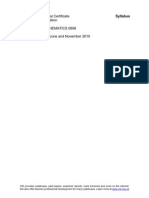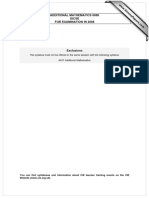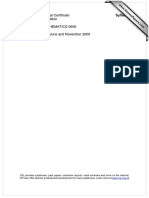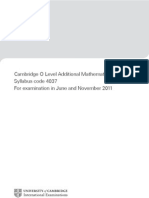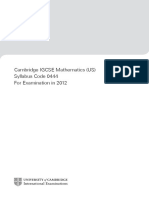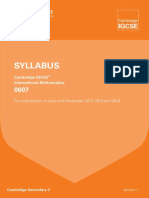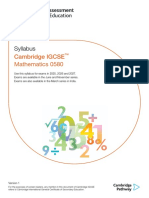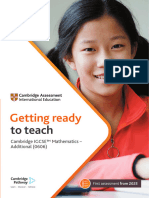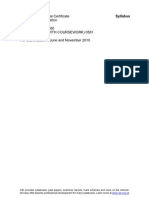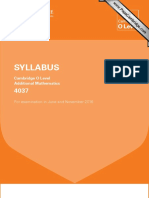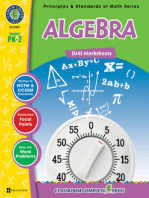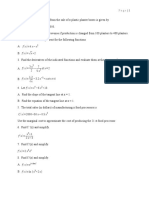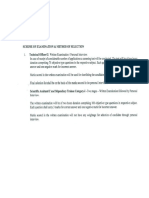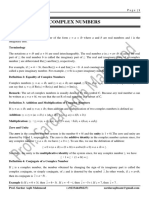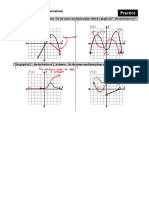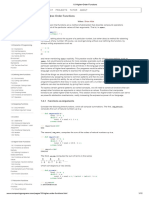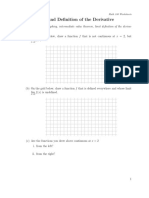0606 Y12 Sy
Uploaded by
rieszen0606 Y12 Sy
Uploaded by
rieszenSyllabus
Cambridge IGCSE Additional Mathematics
Syllabus code 0606
For examination in June and November 2012
Contents
Cambridge IGCSE Additional Mathematics
Syllabus code 0606
1. Introduction ..................................................................................... 2
1.1 Why choose Cambridge?
1.2 Why choose Cambridge IGCSE Additional Mathematics?
1.3 Cambridge International Certificate of Education (ICE)
1.4 How can I find out more?
2. Assessment at a glance .................................................................. 4
3. Syllabus aims and objectives ........................................................... 6
3.1 Aims
3.2 Assessment objectives
4. Syllabus content .............................................................................. 7
5. Additional information .................................................................... 13
5.1 Guided learning hours
5.2 Recommended prior learning
5.3 Progression
5.4 Component codes
5.5 Grading and reporting
5.6 Resources
Cambridge IGCSE Additional Mathematics 0606. Examination in June and November 2012.
UCLES 2009
2
Cambridge IGCSE Additional Mathematics 0606. Examination in June and November 2012.
1. Introduction
1.1 Why choose Cambridge?
University of Cambridge International Examinations (CIE) is the worlds largest provider of international
qualifications. Around 1.5 million students from 150 countries enter Cambridge examinations every year.
What makes educators around the world choose Cambridge?
Recognition
Cambridge IGCSE is internationally recognised by schools, universities and employers as equivalent to UK
GCSE. Cambridge IGCSE is excellent preparation for A/AS Level, the Advanced International Certificate of
Education (AICE), US Advanced Placement Programme and the International Baccalaureate (IB) Diploma.
Learn more at www.cie.org.uk/recognition.
Support
CIE provides a world-class support service for teachers and exams officers. We offer a wide range of
teacher materials to Centres, plus teacher training (online and face-to-face) and student support materials.
Exams officers can trust in reliable, efficient administration of exams entry and excellent, personal support
from CIE Customer Services. Learn more at www.cie.org.uk/teachers.
Excellence in education
Cambridge qualifications develop successful students. They not only build understanding and knowledge
required for progression, but also learning and thinking skills that help students become independent
learners and equip them for life.
Not-for-profit, part of the University of Cambridge
CIE is part of Cambridge Assessment, a not-for-profit organisation and part of the University of Cambridge.
The needs of teachers and learners are at the core of what we do. CIE invests constantly in improving its
qualifications and services. We draw upon education research in developing our qualifications.
3
Cambridge IGCSE Additional Mathematics 0606. Examination in June and November 2012.
1. Introduction
1.2 Why choose Cambridge IGCSE Additional
Mathematics?
Cambridge IGCSE Additional Mathematics is accepted by universities and employers as proof of essential
mathematical knowledge and ability.
The Additional Mathematics syllabus is intended for high ability candidates who have achieved, or are likely
to achieve, Grade A*, A or B in the IGCSE Mathematics examination.
Successful IGCSE Additional Mathematics candidates gain lifelong skills, including:
the further development of mathematical concepts and principles
the extension of mathematical skills and their use in more advanced techniques
an ability to solve problems, present solutions logically and interpret results
a solid foundation for further study.
1.3 Cambridge International Certificate of Education (ICE)
Cambridge ICE is the group award of the International General Certificate of Secondary Education (IGCSE).
It requires the study of subjects drawn from the five different IGCSE subject groups. It gives schools the
opportunity to benefit from offering a broad and balanced curriculum by recognising the achievements of
students who pass examinations in at least seven subjects, including two languages, and one subject from
each of the other subject groups.
The Cambridge portfolio of IGCSE qualifications provides a solid foundation for higher level courses such
as GCE A and AS Levels and the International Baccalaureate Diploma as well as excellent preparation for
employment.
A wide range of IGCSE subjects is available and these are grouped into five curriculum areas. Additional
Mathematics (0606) falls into Group IV, Mathematics.
Learn more about ICE at www.cie.org.uk/qualifications/academic/middlesec/ice.
1.4 How can I find out more?
If you are already a Cambridge Centre
You can make entries for this qualification through your usual channels, e.g. CIE Direct. If you have any
queries, please contact us at [email protected].
If you are not a Cambridge Centre
You can find out how your organisation can become a Cambridge Centre. Email us at
[email protected]. Learn more about the benefits of becoming a Cambridge Centre at
www.cie.org.uk.
4
Cambridge IGCSE Additional Mathematics 0606. Examination in June and November 2012.
2. Assessment at a glance
Cambridge IGCSE Additional Mathematics
Syllabus code 0606
All candidates will take two written papers.
The syllabus content will be assessed by Paper 1 and Paper 2.
Paper Duration Marks
Paper 1
1012 questions of various lengths
No choice of question except that the last question will consist of
two alternatives, only one of which must be answered. The mark
allocations for the last question will be in the range of 1012 marks.
2 hours 80
Paper 2
1012 questions of various lengths
No choice of question except that the last question will consist of
two alternatives, only one of which must be answered. The mark
allocations for the last question will be in the range of 1012 marks.
2 hours 80
Grades A* to E will be available for candidates who achieve the required standards. Since there is no Core
Curriculum for this syllabus, Grades F and G will not be available. Therefore, candidates who do not achieve
the minimum mark for Grade E will be unclassified.
Calculators
The syllabus assumes that candidates will be in possession of an electronic calculator with scientific
functions for both papers.
Non-exact numerical answers will be required to be given correct to three significant figures, or one decimal
place in the case of angles in degrees, unless a different level of accuracy is specified in the question.
List of formulae
Relevant mathematical formulae will be provided on the inside covers of the question papers.
5
Cambridge IGCSE Additional Mathematics 0606. Examination in June and November 2012.
2. Assessment at a glance
Availability
This syllabus is examined in the May/June examination session and the October/November examination
session.
This syllabus is available to private candidates.
Centres in the UK that receive government funding are advised to consult the CIE website www.cie.org.uk
for the latest information before beginning to teach this syllabus.
Combining this with other syllabuses
Candidates can combine this syllabus in an examination session with any other CIE syllabus, except:
syllabuses with the same title at the same level
4037 Additional Mathematics
Please note that IGCSE, Cambridge International Level 1/Level 2 Certificates and O Level syllabuses are at
the same level.
6
Cambridge IGCSE Additional Mathematics 0606. Examination in June and November 2012.
3. Syllabus aims and objectives
3.1 Aims
The aims of the syllabus listed below are not in order of priority.
The aims are to enable candidates to:
consolidate and extend their elementary mathematical skills, and use these in the context of more
advanced techniques
further develop their knowledge of mathematical concepts and principles, and use this knowledge for
problem solving
appreciate the interconnectedness of mathematical knowledge
acquire a suitable foundation in mathematics for further study in the subject or in mathematics related
subjects
devise mathematical arguments and use and present them precisely and logically
integrate information technology (IT) to enhance the mathematical experience
develop the confidence to apply their mathematical skills and knowledge in appropriate situations
develop creativity and perseverance in the approach to problem solving
derive enjoyment and satisfaction from engaging in mathematical pursuits, and gain an appreciation of
the beauty, power and usefulness of mathematics.
3.2 Assessment objectives
The examination will test the ability of candidates to:
recall and use manipulative technique
interpret and use mathematical data, symbols and terminology
comprehend numerical, algebraic and spatial concepts and relationships
recognise the appropriate mathematical procedure for a given situation
formulate problems into mathematical terms and select and apply appropriate techniques of solution.
Any of the above objectives can be assessed in any question in Papers 1 and 2.
7
Cambridge IGCSE Additional Mathematics 0606. Examination in June and November 2012.
4. Syllabus content
The Additional Mathematics syllabus is intended for high ability candidates who have achieved, or are likely
to achieve Grade A*, A or B in the IGCSE Mathematics examination. The curriculum objectives are therefore
assessed at one level only (Extended). As for Extended level syllabuses in other subjects, Grades A* to E
will be available.
The Curriculum objectives (Core and Supplement) for IGCSE Mathematics will be assumed as
prerequisite knowledge.
Proofs of standard results will not be required unless specifically mentioned below.
Candidates will be expected to be familiar with the scientific notation for the expression of compound units,
e.g. 5 m s
1
for 5 metres per second.
8
Cambridge IGCSE Additional Mathematics 0606. Examination in June and November 2012.
4. Syllabus content
Theme or topic Curriculum objectives
Candidates should be able to:
1. Set language and
notation
use set language and notation, and Venn diagrams to describe sets
and represent relationships between sets as follows:
A = {x: x is a natural number}
B = {(x,y): y = mx + c}
C = {x: a Y x Y b}
D = {a, b, c, }
understand and use the following notation:
Union of A and B A B
Intersection of A and B A B
Number of elements in set A n(A)
is an element of
is not an element of
Complement of set A A
The empty set
Universal set
A is a subset of B A B
A is a proper subset of B A B
A is not a subset of B A B
A is not a proper subset of B A B
2. Functions
understand the terms: function, ___domain, range (image set), one-
one function, inverse function and composition of functions
use the notation f(x) = sin x, f: x a lg x (x > 0), f
1
(x) and
f
2
(x) [= f (f(x))]
understand the relationship between y = f(x) and y = f(x)|, where
f(x) may be linear, quadratic or trigonometric
explain in words why a given function is a function or why it does
not have an inverse
find the inverse of a one-one function and form composite
functions
use sketch graphs to show the relationship between a function and
its inverse
9
Cambridge IGCSE Additional Mathematics 0606. Examination in June and November 2012.
4. Syllabus content
Theme or topic Curriculum objectives
3. Quadratic functions
find the maximum or minimum value of the quadratic function
f : x a ax
2
+ bx + c by any method
use the maximum or minimum value of f(x) to sketch the graph or
determine the range for a given ___domain
know the conditions for f(x) = 0 to have:
(i) two real roots, (ii) two equal roots, (iii) no real roots
and the related conditions for a given line to
(i) intersect a given curve, (ii) be a tangent to a given curve,
(iii) not intersect a given curve
solve quadratic equations for real roots and find the solution set for
quadratic inequalities
4. Indices and surds
perform simple operations with indices and with surds, including
rationalising the denominator
5. Factors of polynomials
know and use the remainder and factor theorems
find factors of polynomials
solve cubic equations
6. Simultaneous equations
solve simultaneous equations in two unknowns with at least one
linear equation
7. Logarithmic and
exponential functions
know simple properties and graphs of the logarithmic and
exponential functions including ln
x and e
x
(series expansions are
not required)
know and use the laws of logarithms (including change of base of
logarithms)
solve equations of the form a
x
= b
8. Straight line graphs
interpret the equation of a straight line graph in the form
y = mx + c
transform given relationships, including y = ax
n
and y = Ab
x
, to
straight line form and hence determine unknown constants by
calculating the gradient or intercept of the transformed graph
solve questions involving mid-point and length of a line
know and use the condition for two lines to be parallel or
perpendicular
10
Cambridge IGCSE Additional Mathematics 0606. Examination in June and November 2012.
4. Syllabus content
Theme or topic Curriculum objectives
9. Circular measure
solve problems involving the arc length and sector area of a circle,
including knowledge and use of radian measure
10. Trigonometry
know the six trigonometric functions of angles of any magnitude
(sine, cosine, tangent, secant, cosecant, cotangent)
understand amplitude and periodicity and the relationship between
graphs of e.g. sin x and sin 2x
draw and use the graphs of
y = a sin (bx) + c
y = a cos (bx) + c
y = a tan (bx) + c
where a, b are positive integers and c is an integer
use the relationships
, tan
cos
sin
A
A
A
= , cot
sin
cos
A
A
A
=
and solve simple trigonometric equations involving the six
trigonometric functions and the above relationships (not including
general solution of trigonometric equations)
prove simple trigonometric identities
11. Permutations and
combinations
recognise and distinguish between a permutation case and a
combination case
know and use the notation ! (with 0! = 1), and the expressions for
permutations and combinations of items taken at a time
answer simple problems on arrangement and selection (cases with
repetition of objects, or with objects arranged in a circle or involving
both permutations and combinations, are excluded)
12. Binomial expansions use the Binomial Theorem for expansion of (a + b)
for positive
integral
use the general term
|
|
.
|
\
|
r
n
a
b
, 0 I Y
(knowledge of the greatest term and properties of the coefficients
is not required)
sin
2
A + cos
2
A = 1,
sec
2
A = 1 + tan
2
A, cosec
2
A = 1 + cot
2
A
n
n r
(a + b)
n
n
a
nr
b
r
, 0 I r Y n
11
Cambridge IGCSE Additional Mathematics 0606. Examination in June and November 2012.
4. Syllabus content
Theme or topic Curriculum objectives
13. Vectors in 2 dimensions
use vectors in any form, e.g.
|
|
.
|
\
|
b
a
, AB , p, ai bj
know and use position vectors and unit vectors
find the magnitude of a vector; add and subtract vectors and
multiply vectors by scalars
compose and resolve velocities
use relative velocity, including solving problems on interception
(but not closest approach)
14. Matrices
display information in the form of a matrix of any order and
interpret the data in a given matrix
solve problems involving the calculation of the sum and product
(where appropriate) of two matrices and interpret the results
calculate the product of a scalar quantity and a matrix
use the algebra of 2 2 matrices (including the zero and identity
matrix)
calculate the determinant and inverse of a non-singular 2 2 matrix
and solve simultaneous linear equations
12
Cambridge IGCSE Additional Mathematics 0606. Examination in June and November 2012.
4. Syllabus content
Theme or topic Curriculum objectives
15. Differentiation and
integration
understand the idea of a derived function
use the notations f(x), f(x),
x
y
d
d
,
2
2
d
d
x
y
,
(
|
.
|
\
|
=
x
y
x d
d
d
d
use the derivatives of the standard functions
x
(for any rational ), sin x, cos x, tan x, e
x
, ln
x,
together with constant multiples, sums and composite functions of
these
differentiate products and quotients of functions
apply differentiation to gradients, tangents and normals, stationary
points, connected rates of change, small increments and
approximations and practical maxima and minima problems
discriminate between maxima and minima by any method
understand integration as the reverse process of differentiation
integrate sums of terms in powers of x, excluding
x
1
integrate functions of the form ( x + )
(excluding = 1), e
x+
,
sin ( x + ), cos ( x + )
evaluate definite integrals and apply integration to the evaluation of
plane areas
apply differentiation and integration to kinematics problems that
involve displacement, velocity and acceleration of a particle moving
in a straight line with variable or constant acceleration, and the use
of x
- and
- graphs
x
n
(for any rational n),
(ax + b)
n
(excluding n = 1), e
ax+b
,
x
t and v
t graphs
sin (ax + b), cos (ax + b)
13
Cambridge IGCSE Additional Mathematics 0606. Examination in June and November 2012.
5. Additional information
5.1 Guided learning hours
IGCSE syllabuses are designed on the assumption that candidates have about 130 guided learning hours
per subject over the duration of the course. (Guided learning hours include direct teaching and any other
supervised or directed study time. They do not include private study by the candidate.)
However, this figure is for guidance only, and the number of hours required may vary according to local
curricular practice and the candidates prior experience of the subject.
5.2 Recommended prior learning
We recommend that candidates who are beginning this course should be currently studying or have
previously studied IGCSE or O Level Mathematics.
5.3 Progression
IGCSE Certificates are general qualifications that enable candidates to progress either directly to
employment, or to proceed to further qualifications.
Candidates who are awarded grades C to A* in IGCSE Additional Mathematics are well prepared to follow
courses leading to AS and A Level Mathematics, or the equivalent.
5.4 Component codes
Because of local variations, in some cases component codes will be different in instructions about making
entries for examinations and timetables from those printed in this syllabus, but the component names will
be unchanged to make identification straightforward.
5.5 Grading and reporting
IGCSE results are shown by one of the grades A*, A, B, C, D, E, F or G indicating the standard achieved,
Grade A* being the highest and Grade G the lowest. Ungraded indicates that the candidates performance
fell short of the standard required for Grade G. Ungraded will be reported on the statement of results but
not on the certificate. For some language syllabuses CIE also reports separate oral endorsement grades on
a scale of 1 to 5 (1 being the highest).
14
Cambridge IGCSE Additional Mathematics 0606. Examination in June and November 2012.
5. Additional information
Percentage uniform marks are also provided on each candidates Statement of Results to supplement their
grade for a syllabus. They are determined in this way:
A candidate who obtains
the minimum mark necessary for a Grade A* obtains a percentage uniform mark of 90%.
the minimum mark necessary for a Grade A obtains a percentage uniform mark of 80%.
the minimum mark necessary for a Grade B obtains a percentage uniform mark of 70%.
the minimum mark necessary for a Grade C obtains a percentage uniform mark of 60%.
the minimum mark necessary for a Grade D obtains a percentage uniform mark of 50%.
the minimum mark necessary for a Grade E obtains a percentage uniform mark of 40%.
the minimum mark necessary for a Grade F obtains a percentage uniform mark of 30%.
the minimum mark necessary for a Grade G obtains a percentage uniform mark of 20%.
no marks receives a percentage uniform mark of 0%.
Candidates whose mark is none of the above receive a percentage mark in between those stated according
to the position of their mark in relation to the grade thresholds (i.e. the minimum mark for obtaining a
grade). For example, a candidate whose mark is halfway between the minimum for a Grade C and the
minimum for a Grade D (and whose grade is therefore D) receives a percentage uniform mark of 55%.
The uniform percentage mark is stated at syllabus level only. It is not the same as the raw mark obtained
by the candidate, since it depends on the position of the grade thresholds (which may vary from one session
to another and from one subject to another) and it has been turned into a percentage.
5.6 Resources
Copies of syllabuses, the most recent question papers and Principal Examiners reports are available on the
Syllabus and Support Materials CD-ROM, which is sent to all CIE Centres.
Resources are also listed on CIEs public website at www.cie.org.uk. Please visit this site on a regular
basis as the Resource lists are updated through the year.
Access to teachers email discussion groups, suggested schemes of work and regularly updated resource
lists may be found on the CIE Teacher Support website at http://teachers.cie.org.uk. This website is
available to teachers at registered CIE Centres.
University of Cambridge International Examinations
1 Hills Road, Cambridge, CB1 2EU, United Kingdom
Tel: +44 (0)1223 553554 Fax: +44 (0)1223 553558
Email: [email protected] Website: www.cie.org.uk
University of Cambridge International Examinations 2009
You might also like
- Digital SAT Preview: What to Expect + Tips and StrategiesFrom EverandDigital SAT Preview: What to Expect + Tips and Strategies5/5 (4)
- Syllabus: Cambridge IGCSE Additional MathematicsNo ratings yetSyllabus: Cambridge IGCSE Additional Mathematics20 pages
- Syllabus: Cambridge International CertificateNo ratings yetSyllabus: Cambridge International Certificate46 pages
- HYE Syllabus Dec 202 4 Grade 9 Additional MathNo ratings yetHYE Syllabus Dec 202 4 Grade 9 Additional Math31 pages
- Additional Mathematics 2025 2027 SyllabusNo ratings yetAdditional Mathematics 2025 2027 Syllabus31 pages
- Additional Mathematics 0606 Igcse For Examination in 2008No ratings yetAdditional Mathematics 0606 Igcse For Examination in 200810 pages
- International General Certificate Syllabus of Secondary Education Additional Mathematics 0606 For Examination in June and November 2009No ratings yetInternational General Certificate Syllabus of Secondary Education Additional Mathematics 0606 For Examination in June and November 200910 pages
- Syllabus: Cambridge IGCSE Additional Mathematics (US)No ratings yetSyllabus: Cambridge IGCSE Additional Mathematics (US)22 pages
- Syllabus: Cambridge IGCSE International MathematicsNo ratings yetSyllabus: Cambridge IGCSE International Mathematics29 pages
- Learner Guide For Cambridge Igcse Additional Mathematics 0606No ratings yetLearner Guide For Cambridge Igcse Additional Mathematics 060639 pages
- Syllabus: Cambridge IGCSE International MathematicsNo ratings yetSyllabus: Cambridge IGCSE International Mathematics29 pages
- Introducing Changes To Cambridge Igcse Mathematics 0580 0980 and Cambridge Igcse Additional Mathematics 0606100% (1)Introducing Changes To Cambridge Igcse Mathematics 0580 0980 and Cambridge Igcse Additional Mathematics 060625 pages
- IGCSE Math_0580_Subject Contents (2025-2027)No ratings yetIGCSE Math_0580_Subject Contents (2025-2027)46 pages
- Syllabus Differences: March 2015 Series (India Only) : Mathematics 0606 (For 2015)No ratings yetSyllabus Differences: March 2015 Series (India Only) : Mathematics 0606 (For 2015)1 page
- Syllabus: Cambridge O Level Additional MathematicsNo ratings yetSyllabus: Cambridge O Level Additional Mathematics21 pages
- IGCSE Additional Mathematics (0606) Frequently Asked Questions0% (1)IGCSE Additional Mathematics (0606) Frequently Asked Questions1 page
- Syllabus: Cambridge O Level Additional MathematicsNo ratings yetSyllabus: Cambridge O Level Additional Mathematics21 pages
- Getting Ready Factsheet For Igcse Maths AdditionalNo ratings yetGetting Ready Factsheet For Igcse Maths Additional4 pages
- Important Notice: Additional Mathematics 4037 GCE O Level 2007No ratings yetImportant Notice: Additional Mathematics 4037 GCE O Level 200715 pages
- Syllabus: Cambridge IGCSE® Mathematics 0580No ratings yetSyllabus: Cambridge IGCSE® Mathematics 058044 pages
- Additional Mathematics: Cambridge International General Certificate of Secondary EducationNo ratings yetAdditional Mathematics: Cambridge International General Certificate of Secondary Education1 page
- 0980 Scheme of Work (For Examination From 2020)No ratings yet0980 Scheme of Work (For Examination From 2020)52 pages
- Syllabus: Cambridge O Level Additional MathematicsNo ratings yetSyllabus: Cambridge O Level Additional Mathematics21 pages
- Additional Mathematics 4037 Syllabus UpdatedNo ratings yetAdditional Mathematics 4037 Syllabus Updated21 pages
- The Ultimate ENGAA Guide: Engineering Admissions Assessment preparation resources - 2022 entry, 400+ practice questions and past papers, worked solutions, techniques, score boostingFrom EverandThe Ultimate ENGAA Guide: Engineering Admissions Assessment preparation resources - 2022 entry, 400+ practice questions and past papers, worked solutions, techniques, score boostingNo ratings yet
- Master the New York City Specialized High School Admissions TestFrom EverandMaster the New York City Specialized High School Admissions TestNo ratings yet
- 1.6 Differentiation Techniques Product and Quotient RulesNo ratings yet1.6 Differentiation Techniques Product and Quotient Rules3 pages
- Updated Syllabus - BoS - B.Sc. Hons. AgricultureNo ratings yetUpdated Syllabus - BoS - B.Sc. Hons. Agriculture96 pages
- Applications Geogebra Into Teaching Some Topics of Mathematics at The College LevelNo ratings yetApplications Geogebra Into Teaching Some Topics of Mathematics at The College Level14 pages
- Syllabus For BITSAT-2019 Part I: Physics: AnnexureNo ratings yetSyllabus For BITSAT-2019 Part I: Physics: Annexure12 pages
- Maths Class Xii Mock Test Paper 05 For 2017 18No ratings yetMaths Class Xii Mock Test Paper 05 For 2017 184 pages
- 5.8 Sketching Graphs of Derivatives: PracticeNo ratings yet5.8 Sketching Graphs of Derivatives: Practice5 pages
- Ncert Solutions Class 12 Maths Chapter 9 Ex 9 1 PDFNo ratings yetNcert Solutions Class 12 Maths Chapter 9 Ex 9 1 PDF6 pages
- MAT060 14 Higher Order Derivatives Bent UsmanNo ratings yetMAT060 14 Higher Order Derivatives Bent Usman11 pages
- D.05 Rates of Change HW: Proof (Work or Explanation)No ratings yetD.05 Rates of Change HW: Proof (Work or Explanation)2 pages
- Class X Mathematics: Page No. Dropped Topics/ChapterNo ratings yetClass X Mathematics: Page No. Dropped Topics/Chapter6 pages
- [Ebooks PDF] download Teaching secondary school mathematics research and practice for the 21st century Geiger full chaptersNo ratings yet[Ebooks PDF] download Teaching secondary school mathematics research and practice for the 21st century Geiger full chapters65 pages
- Syllabus For Calculus I-2023-2024 Fall Semester REVISEDNo ratings yetSyllabus For Calculus I-2023-2024 Fall Semester REVISED3 pages
- 3 Continuity and Definition of The Derivative: Math 180 WorksheetsNo ratings yet3 Continuity and Definition of The Derivative: Math 180 Worksheets4 pages








